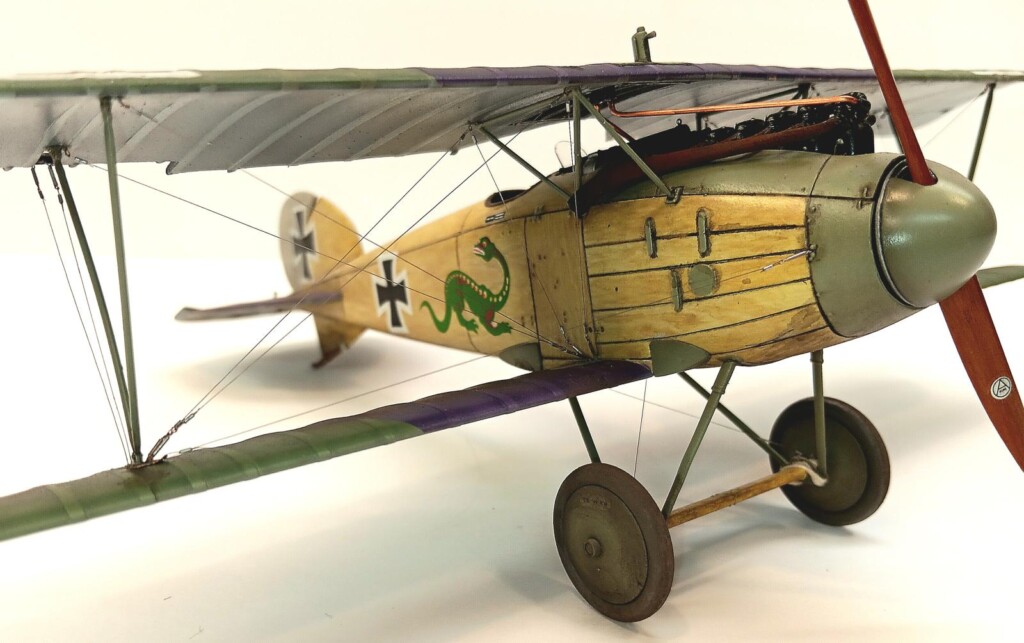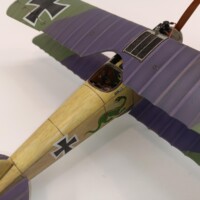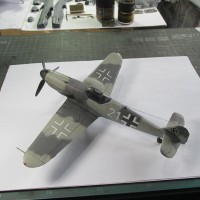Roden 1/32nd Albatros DIII (OAW)
Hello everyone, this is my Roden Albatros DIII (OAW) in 1/32nd scale. To start, its no Wingnut Wings kit but the Roden kits can be built into a pretty nice piece.
I've always been a fan of the German WW1 aircraft, and the Albatros family of fighters is at the top. This kit represents the DIII version built by Ostdeutsche Albatroswerke G.m.b.H. in Schneidemühl Germany, (OAW).
The DIII was introduced in 1917 at the same time development of its successor the Dv was going on, so Albatros, located in Johannisthal Germany, decided that OAW should take over production of the DIII and they would concentrate on developing the Dv. In total Albatros would build 500 DIIIs and OAW built 838. The difference visually is minor, Albatros DIIIs have a "flat" rudder wile OAW built DIIIs have a rounded rudder more like the Dv and Dv-a. There are a couple other minor differences that only a fanatic could pick out, ( I couldn't).
The DIII was the first Albatros to have the Newport 11 style wing arrangement with the V strut and lower wing that was shorter in length and in cord wile the upper wing was lengthened. The DIIIs fuselage was a semi-monocoque plywood skinned slab sided arrangement like the DI and DII. The Dv and Dv-a had the more elegant elliptical cross section fuselage design.
The DIII used the same 170hp Mercedes Dlll.a inline 6cyl. engine used in the Dv. Later Dv and Dv-a variants used larger 180hp displacement Mercedes engines.
The DIII varrent became a "work horse" of the German air force during WW1 as the Dv was esenchaly recalled for factory upgrades because of design falts. These upgrades became incorporated into the Dv-a but the weak wing problem that pledged the Dv was never completely resolved. A quick way to tell a DVD from a Dv-a is a small brace on the bottom wing connected to the front of the V strut to near the leading edge of the wing. It was supposed to keep the wing from twisting, but didn't help much.
The DIII was a highly successful and effective early to mid WW1 fighter that saw action on the western front in France to the near Eastern front, from 1917 to the end of the war.
Many German experts of the day, including Manfred von Richthofon said that compared to the later Dv and Dv-a, (which had many problems, mostly to do with wing construction) the DIII was a better aircraft in many technical respects.
Now, on to the kit. I added rib tape details with narrow strips of tape as none are hinted at. I made my own turnbuckles from aluminum micro tubeing and small gage copper wire. Check out http://www.ww1aircraftmodels.com to see how there constructed. I added valve springs and ignition wires to the fairly good kit rendition of the Mercedes Dlll.a engine and made radiator connections with heavy gage florest wire. I also added the bungee cord suspension detail for the landing gear from waxed string. The machine guns are Wingnut wings units from a kit in my stash.
The fuselage was painted with Mission Models paints (code numbers mmp-082 German white, and mmp-016 sandgruau) all done by brush, following an article in Meng air modeler from the April/May 2018 issue by David Parker. In the article he shows you step by step his procedure for painting realistic woodgrain using only these two colors. Other colors could be used for darker wood tones. After the woodgraining is finished a top coat of Tamiya clear yellow or orange is applied. I used yellow to keep it on the lighter side.
The wings and everything else was painted using Tamiya and Vallejo paints with my normal oil paints for the weathering.
Rigging was done with smoke colored "invisible" nylon mending thread and my homemade turnbuckles mentioned above.
All in all, I'm pretty happy with how this little bird came out. Roden makes some subjects that I wish Wingnut wings would have produced, so I definitely recommend checking out their kits. With a little added work and attention, the Roden kits build up in to some beautiful little models.
Hope I didn't ramble on for to long. And everyone enjoys taking a look.
Happy modeling!























An absolutely superb result, Clint! Outstanding painting and weathering, awesome rigging!
Congratulations!
Thanks Spiros, I appreciate your kind words.
Great work on this kit, Clint, your additions have brought it up to WnW’s standards.
Thank you very much. I tried my hardest
Lovely build, Clint!
Thanks Gary. I appreciate it.
That is magnificent work, Clint @curtisshawk! You've produced a fantastic Great War bird that anyone would love to have. Great scale modeling, for sure!
You've produced a fantastic Great War bird that anyone would love to have. Great scale modeling, for sure! 
Thanks so much. It's one of my favorite builds.
Really nice work! The wood is superb, the wing fabric, all the detail. A great result.
Thank you Tom. I appreciate your kind comments very much.
Really nice kit, and excellent woodwork!
Thanks Jarmo. The Meng article on doing the woodgrain was excellent and easy to follow. I got good results on the first try.
Great wood effect, great detail, amazing build.
Thank you so much, it's greatly appreciated.
An outstanding piece of craftsmanship! Such an eye-catching model.
Thank you for the kind words John. I've always been a fan of German WW1 aircraft. I bought this kit before Wingnut came out with there Dv/Dv-a. The Roden kits build up pretty nice.
Speechless with this result, Clint @curtisshawk
So much realism on every part of this build, the paintwork, rigging, detailing, superb.
Well done.
Thank you John, very much, I appreciate it.
Great portrait of the Albatross D111, my favourite German WW1 fighter, well done.
Thanks Ian, I'm a fan of the Albatros Dlll and Dv series too.some of my favorite WW1 fighters.
Nice result! The Roden kits definitely require more care then WNW did.
Thanks. Roden kits definitely do require more attention, but they offer some subjects that Wingnut didn't. I don't mind putting in the extra effort, it's what makes modeling fun!
Just a spectacular build all the way around!
Thanks Greg, much appreciated!
Well, he's a handsome man. It's gorgeous, I need to get into 1:32 sometime too.
Thanks Milan. I have a few 1/48 scale WW1 kits, but most are in 1/32 scale. Their much easier to do the rigging on.